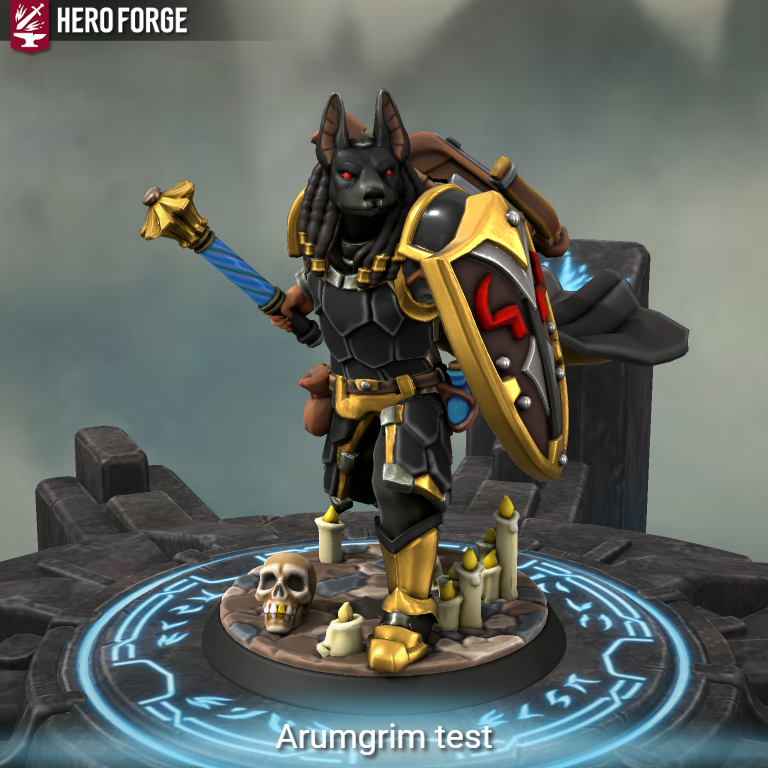Arumgrim Shigorn
Arumgrim, Cleric of Anubis.... Deep in the south of Faerun in a region known as Mulhorand lies the Mishtan also known as "Land of the Dead" or "City of the Dead". Far from the halls of Osiris well into the city of the dead lies a temple to the "Forgotten God" Anubis. After his parent give him to the priesthood of Nephthys the mourning goddess in Neldorild, a large city where many rich Mulhorandi came to Neldorild to retire and enjoy the rest of their lives. The priests and priestesses of Nephthys found a strange detachment that seemed unbefitting of someone intended to mourn. So they gathered his belongings (what few he had) and sent him far southeast down the river of spears to the small city of Ulzel to serve as a cleric of Osiris, sensing his potential the priests of Osiris sent him to study in Mishtan with father Nathandem in the hidden temple of Anubis deep within the City of the Dead. Arumgrim was so adept at learning the ways of the temple that they enlisted him as a professor to help teach the other acolytes.
One day the headmaster sent word that he was to travel to the city of Iriaebor in the north to discover rumors of an ancient evil awakening in the Sunset Vale.
Divine Domains
Death, Grave, Judgement
Tenets of Faith
Dogma: Anubis guides the souls of dead mortals to the halls of judgement, supervises their weighing on the Scales of Ma’at and protects them on their journey. In addition, he guards cemeteries from grave robbers and other defilers. Anubis helped his mother Nut and his sister Isis mummify Osiris (his father), applying his knowledge of herbs and medicines. He also a keeper of magical knowledge, particularly that related to necromancy. Despite his knowledge of necromancy, he does not condone animating or controlling undead creatures, with the exception of mummies established as tomb guardians.
In his role as the collector of souls for transportation to the house of the dead, there is a chance that a dead being (worshiping any Egyptian deity) will, while in the process of being raised from the dead by a cleric, attract the anger of the god, and as a result that cleric will be forced to go on a quest for the purpose of increasing the power of the Church of Anubis.
Clergy and Temples
Followers of Anubis practice rigorous disciplines to hone their minds and spirits, preparing themselves for the eventual journey to the afterlife. The Judge of the Dead has few devotees, but he is often worshiped at funerals, where his clerics typically officiate.
Priestly Vestments: Priests of Anubis usually wear plain white robes outside of the sanctum. When accompanying a body to its final resting place they will don masks of gold representing their god and hiding their faces. In the sanctum, however, pirests of Anubis must not wear clothing at all since this would contaminate the sanctum. For the same reason priests of Anubis shave off all body hair. If a priest were to enter the sanctum without being cleanly shaven he or she would surely pollute its sanctity.
Adventuring Garb: Clerics of Anubis rarely go adventuring. Their elaborate cleansing rituals are easily enough to fill a lifetime with labor. If they go adventuring, however, they will use whatever equipment is practical. Most adventuring clerics of Anubis shave clean all the time, even though they do not enter a temple sanctuary often.
Temples and Shrines of Anubis are by far the most common religious institutions in Baldari. Since all faithful or tradition conscious Baldarians will want the cleansing ceremony performed on them after death each village has at least a shrine to Anubis whereas cities will have at least one temple and several shrines dedicated to the priesthood of Anubis.
When one dies and becomes judged by Anubis using the heart ceremony is an important factor of the Egyptian mythology. In this ceremony, the heart is weighed, by Anubis, against an Ostrich Feather of Truth. If the heart was lighter then the feather then the soul could pass on, but if the heart was heavier then the feather the soul would be devoured by Ammit. Ammit is said to live near the Scales, in Duat, the underworld.
Holidays
Holy Days/Important Ceremonies: The Inner sanctum of a temple or shrine of Anubis may only be entered by the dead or a priest of Anubis. Here is where the cleansing ceremony of the deceased’s body will take place. Since death is free of time there is no “holy day” celebrated by Anubite priests.
Invocation to Anubis
Lord of the desert sands
Who guides lost souls through endless waste
Into a better land
Who brings the Dead
To their final judgment
Into the hand of Ma’at
Great-eared one who sniffs out
All things hidden
And from whom nothing
Can be concealed forever,
Guide us surely and skillfully
Out of the darkness
Of our own blind searching.

Cleric of Anubis
View Character Profile
Divine Classification
Deity
Current Location
Species
Realm
Church/Cult
Age
22
Birthplace
Mulhorand
Children
Current Residence
Asbravn
Gender
male
Eyes
Green
Hair
Gray
Skin Tone/Pigmentation
Light Brown
Height
6'1"
Weight
195 lbs.
Remove these ads. Join the Worldbuilders Guild









Comments